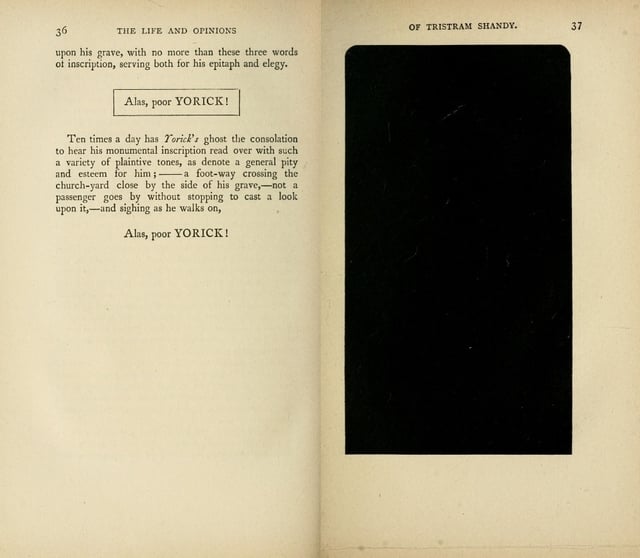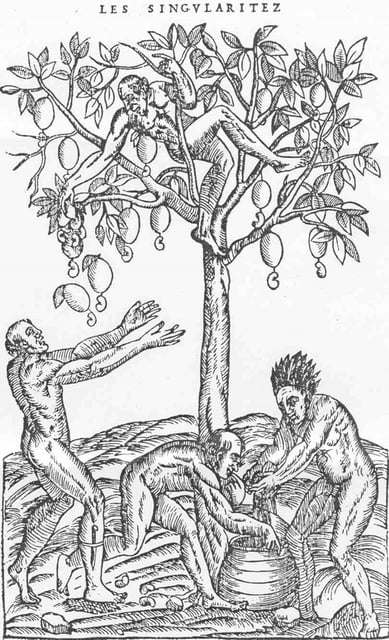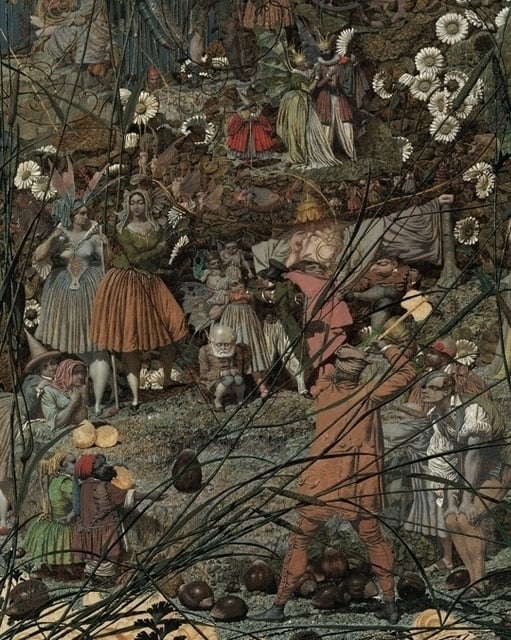Gustav Wunderwald’s Paintings of Weimar Berlin
May 31, 2017
Painting & Art
 The Berlin of the 1920s is often associated with a certain excess and decadence, but it was a quite different side of the city — the “sobriety and desolation” of its industrial and working-class districts — which came to obsess the painter Gustav Wunderwald. Mark Hobbs explores.
Tribal Life in Old Lyme: Canada’s Colorblind Chronicler and his Connecticut Exile
September 2, 2015
Books & Painting & Art
Abigail Walthausen explores the life and work of Arthur Heming, the Canadian painter who — having been diagnosed with colourblindness as a child — worked for most of his life in a distinctive palette of black, yellow, and white.
Black on Black
April 9, 2015
Books & Painting & Science & Philosophy
The Berlin of the 1920s is often associated with a certain excess and decadence, but it was a quite different side of the city — the “sobriety and desolation” of its industrial and working-class districts — which came to obsess the painter Gustav Wunderwald. Mark Hobbs explores.
Tribal Life in Old Lyme: Canada’s Colorblind Chronicler and his Connecticut Exile
September 2, 2015
Books & Painting & Art
Abigail Walthausen explores the life and work of Arthur Heming, the Canadian painter who — having been diagnosed with colourblindness as a child — worked for most of his life in a distinctive palette of black, yellow, and white.
Black on Black
April 9, 2015
Books & Painting & Science & Philosophy
 Should we consider black a colour, the absence of colour, or a suspension of vision produced by a deprivation of light? Beginning with Robert Fludd’s attempt to picture nothingness, Eugene Thacker reflects* on some of the ways in which blackness has been used and thought about through the history of art and philosophical thought.
Sex and Science in Robert Thornton’s Temple of Flora
March 11, 2015
Books & Poems & Painting & Science & Art
Should we consider black a colour, the absence of colour, or a suspension of vision produced by a deprivation of light? Beginning with Robert Fludd’s attempt to picture nothingness, Eugene Thacker reflects* on some of the ways in which blackness has been used and thought about through the history of art and philosophical thought.
Sex and Science in Robert Thornton’s Temple of Flora
March 11, 2015
Books & Poems & Painting & Science & Art
 Bridal beds, blushing captives, and swollen trunks – Carl Linnaeus’ taxonomy of plants heralded a whole new era in 18th-century Europe of plants being spoken of in sexualised terms. Martin Kemp explores* how this association between the floral and erotic reached its visual zenith in Robert Thornton’s exquisitely illustrated Temple of Flora.
Victorian Occultism and the Art of Synesthesia
March 19, 2014
Books & Painting & Philosophy & Art
Grounded in the theory that ideas, emotions, and even events, can manifest as visible auras, Annie Besant and Charles Leadbeater’s Thought-Forms (1901) is an odd and intriguing work. Benjamin Breen explores these “synesthetic” abstractions and asks to what extent they, and the Victorian mysticism of which they were born, influenced the Modernist movement that flourished in the following decades.
Olaus Magnus’ Sea Serpent
February 5, 2014
Painting & Science & Art
Bridal beds, blushing captives, and swollen trunks – Carl Linnaeus’ taxonomy of plants heralded a whole new era in 18th-century Europe of plants being spoken of in sexualised terms. Martin Kemp explores* how this association between the floral and erotic reached its visual zenith in Robert Thornton’s exquisitely illustrated Temple of Flora.
Victorian Occultism and the Art of Synesthesia
March 19, 2014
Books & Painting & Philosophy & Art
Grounded in the theory that ideas, emotions, and even events, can manifest as visible auras, Annie Besant and Charles Leadbeater’s Thought-Forms (1901) is an odd and intriguing work. Benjamin Breen explores these “synesthetic” abstractions and asks to what extent they, and the Victorian mysticism of which they were born, influenced the Modernist movement that flourished in the following decades.
Olaus Magnus’ Sea Serpent
February 5, 2014
Painting & Science & Art
 The terrifying Great Norway Serpent, or Sea Orm, is the most famous of the many influential sea monsters depicted and described by 16th-century ecclesiastic, cartographer, and historian Olaus Magnus. Joseph Nigg, author of Sea Monsters, explores the iconic and literary legacy of the controversial serpent from its beginnings in the medieval imagination to modern cryptozoology.
The Serious and the Smirk: The Smile in Portraiture
September 18, 2013
Photography & Painting & Art
Why do we so seldom see people smiling in painted portraits? Nicholas Jeeves explores the history of the smile through the ages of portraiture, from Da Vinci’s Mona Lisa to Alexander Gardner’s photographs of Abraham Lincoln.
Joseph Banks: Portraits of a Placid Elephant
April 4, 2013
Painting & Science & Art & History
Patricia Fara traces the changing iconography of Joseph Banks, the English botanist who travelled on Captain Cook’s first great voyage and went on to become President of the Royal Society and important patron for a whole host of significant developments in the natural sciences.
John Martin and the Theatre of Subversion
July 12, 2012
Painting & Art & History
Max Adams, author of The Prometheans, looks at the art of John Martin and how in his epic landscapes of apocalyptic scale one can see reflected his revolutionary leanings.
Seeing Joyce
June 12, 2012
Books & Painting & Literature
The terrifying Great Norway Serpent, or Sea Orm, is the most famous of the many influential sea monsters depicted and described by 16th-century ecclesiastic, cartographer, and historian Olaus Magnus. Joseph Nigg, author of Sea Monsters, explores the iconic and literary legacy of the controversial serpent from its beginnings in the medieval imagination to modern cryptozoology.
The Serious and the Smirk: The Smile in Portraiture
September 18, 2013
Photography & Painting & Art
Why do we so seldom see people smiling in painted portraits? Nicholas Jeeves explores the history of the smile through the ages of portraiture, from Da Vinci’s Mona Lisa to Alexander Gardner’s photographs of Abraham Lincoln.
Joseph Banks: Portraits of a Placid Elephant
April 4, 2013
Painting & Science & Art & History
Patricia Fara traces the changing iconography of Joseph Banks, the English botanist who travelled on Captain Cook’s first great voyage and went on to become President of the Royal Society and important patron for a whole host of significant developments in the natural sciences.
John Martin and the Theatre of Subversion
July 12, 2012
Painting & Art & History
Max Adams, author of The Prometheans, looks at the art of John Martin and how in his epic landscapes of apocalyptic scale one can see reflected his revolutionary leanings.
Seeing Joyce
June 12, 2012
Books & Painting & Literature
 This year’s ‘Bloomsday’ – 108 years after Leopold Bloom took his legendary walk around Dublin on the 16th June 1904 – is the first since the works of James Joyce entered the public domain. Frank Delaney asks whether we should perhaps now stop trying to read Joyce and instead make visits to him as to a gallery.
Painting the New World
April 24, 2012
Painting & Art & History
This year’s ‘Bloomsday’ – 108 years after Leopold Bloom took his legendary walk around Dublin on the 16th June 1904 – is the first since the works of James Joyce entered the public domain. Frank Delaney asks whether we should perhaps now stop trying to read Joyce and instead make visits to him as to a gallery.
Painting the New World
April 24, 2012
Painting & Art & History
 In 1585 the Englishman John White, governor of one of the very first North American colonies, made a series of exquisite watercolour sketches of the native Algonkin people alongside whom the settlers would try to live. Benjamin Breen explores the significance of the sketches and their link to the mystery of what became known as the “Lost Colony”.
Richard Dadd’s Master-Stroke
March 14, 2012
Painting & Art
In 1585 the Englishman John White, governor of one of the very first North American colonies, made a series of exquisite watercolour sketches of the native Algonkin people alongside whom the settlers would try to live. Benjamin Breen explores the significance of the sketches and their link to the mystery of what became known as the “Lost Colony”.
Richard Dadd’s Master-Stroke
March 14, 2012
Painting & Art
 Nicholas Tromans, author of Richard Dadd: The Artist and the Asylum, takes a look at Dadd’s most famous painting The Fairy Feller’s Master-Stroke.
Nicholas Tromans, author of Richard Dadd: The Artist and the Asylum, takes a look at Dadd’s most famous painting The Fairy Feller’s Master-Stroke.
 The Berlin of the 1920s is often associated with a certain excess and decadence, but it was a quite different side of the city — the “sobriety and desolation” of its industrial and working-class districts — which came to obsess the painter Gustav Wunderwald. Mark Hobbs explores.
Tribal Life in Old Lyme: Canada’s Colorblind Chronicler and his Connecticut Exile
September 2, 2015
Books & Painting & Art
Abigail Walthausen explores the life and work of Arthur Heming, the Canadian painter who — having been diagnosed with colourblindness as a child — worked for most of his life in a distinctive palette of black, yellow, and white.
Black on Black
April 9, 2015
Books & Painting & Science & Philosophy
The Berlin of the 1920s is often associated with a certain excess and decadence, but it was a quite different side of the city — the “sobriety and desolation” of its industrial and working-class districts — which came to obsess the painter Gustav Wunderwald. Mark Hobbs explores.
Tribal Life in Old Lyme: Canada’s Colorblind Chronicler and his Connecticut Exile
September 2, 2015
Books & Painting & Art
Abigail Walthausen explores the life and work of Arthur Heming, the Canadian painter who — having been diagnosed with colourblindness as a child — worked for most of his life in a distinctive palette of black, yellow, and white.
Black on Black
April 9, 2015
Books & Painting & Science & Philosophy
 Should we consider black a colour, the absence of colour, or a suspension of vision produced by a deprivation of light? Beginning with Robert Fludd’s attempt to picture nothingness, Eugene Thacker reflects* on some of the ways in which blackness has been used and thought about through the history of art and philosophical thought.
Sex and Science in Robert Thornton’s Temple of Flora
March 11, 2015
Books & Poems & Painting & Science & Art
Should we consider black a colour, the absence of colour, or a suspension of vision produced by a deprivation of light? Beginning with Robert Fludd’s attempt to picture nothingness, Eugene Thacker reflects* on some of the ways in which blackness has been used and thought about through the history of art and philosophical thought.
Sex and Science in Robert Thornton’s Temple of Flora
March 11, 2015
Books & Poems & Painting & Science & Art
 Bridal beds, blushing captives, and swollen trunks – Carl Linnaeus’ taxonomy of plants heralded a whole new era in 18th-century Europe of plants being spoken of in sexualised terms. Martin Kemp explores* how this association between the floral and erotic reached its visual zenith in Robert Thornton’s exquisitely illustrated Temple of Flora.
Victorian Occultism and the Art of Synesthesia
March 19, 2014
Books & Painting & Philosophy & Art
Grounded in the theory that ideas, emotions, and even events, can manifest as visible auras, Annie Besant and Charles Leadbeater’s Thought-Forms (1901) is an odd and intriguing work. Benjamin Breen explores these “synesthetic” abstractions and asks to what extent they, and the Victorian mysticism of which they were born, influenced the Modernist movement that flourished in the following decades.
Olaus Magnus’ Sea Serpent
February 5, 2014
Painting & Science & Art
Bridal beds, blushing captives, and swollen trunks – Carl Linnaeus’ taxonomy of plants heralded a whole new era in 18th-century Europe of plants being spoken of in sexualised terms. Martin Kemp explores* how this association between the floral and erotic reached its visual zenith in Robert Thornton’s exquisitely illustrated Temple of Flora.
Victorian Occultism and the Art of Synesthesia
March 19, 2014
Books & Painting & Philosophy & Art
Grounded in the theory that ideas, emotions, and even events, can manifest as visible auras, Annie Besant and Charles Leadbeater’s Thought-Forms (1901) is an odd and intriguing work. Benjamin Breen explores these “synesthetic” abstractions and asks to what extent they, and the Victorian mysticism of which they were born, influenced the Modernist movement that flourished in the following decades.
Olaus Magnus’ Sea Serpent
February 5, 2014
Painting & Science & Art
 The terrifying Great Norway Serpent, or Sea Orm, is the most famous of the many influential sea monsters depicted and described by 16th-century ecclesiastic, cartographer, and historian Olaus Magnus. Joseph Nigg, author of Sea Monsters, explores the iconic and literary legacy of the controversial serpent from its beginnings in the medieval imagination to modern cryptozoology.
The Serious and the Smirk: The Smile in Portraiture
September 18, 2013
Photography & Painting & Art
Why do we so seldom see people smiling in painted portraits? Nicholas Jeeves explores the history of the smile through the ages of portraiture, from Da Vinci’s Mona Lisa to Alexander Gardner’s photographs of Abraham Lincoln.
Joseph Banks: Portraits of a Placid Elephant
April 4, 2013
Painting & Science & Art & History
Patricia Fara traces the changing iconography of Joseph Banks, the English botanist who travelled on Captain Cook’s first great voyage and went on to become President of the Royal Society and important patron for a whole host of significant developments in the natural sciences.
John Martin and the Theatre of Subversion
July 12, 2012
Painting & Art & History
Max Adams, author of The Prometheans, looks at the art of John Martin and how in his epic landscapes of apocalyptic scale one can see reflected his revolutionary leanings.
Seeing Joyce
June 12, 2012
Books & Painting & Literature
The terrifying Great Norway Serpent, or Sea Orm, is the most famous of the many influential sea monsters depicted and described by 16th-century ecclesiastic, cartographer, and historian Olaus Magnus. Joseph Nigg, author of Sea Monsters, explores the iconic and literary legacy of the controversial serpent from its beginnings in the medieval imagination to modern cryptozoology.
The Serious and the Smirk: The Smile in Portraiture
September 18, 2013
Photography & Painting & Art
Why do we so seldom see people smiling in painted portraits? Nicholas Jeeves explores the history of the smile through the ages of portraiture, from Da Vinci’s Mona Lisa to Alexander Gardner’s photographs of Abraham Lincoln.
Joseph Banks: Portraits of a Placid Elephant
April 4, 2013
Painting & Science & Art & History
Patricia Fara traces the changing iconography of Joseph Banks, the English botanist who travelled on Captain Cook’s first great voyage and went on to become President of the Royal Society and important patron for a whole host of significant developments in the natural sciences.
John Martin and the Theatre of Subversion
July 12, 2012
Painting & Art & History
Max Adams, author of The Prometheans, looks at the art of John Martin and how in his epic landscapes of apocalyptic scale one can see reflected his revolutionary leanings.
Seeing Joyce
June 12, 2012
Books & Painting & Literature
 This year’s ‘Bloomsday’ – 108 years after Leopold Bloom took his legendary walk around Dublin on the 16th June 1904 – is the first since the works of James Joyce entered the public domain. Frank Delaney asks whether we should perhaps now stop trying to read Joyce and instead make visits to him as to a gallery.
Painting the New World
April 24, 2012
Painting & Art & History
This year’s ‘Bloomsday’ – 108 years after Leopold Bloom took his legendary walk around Dublin on the 16th June 1904 – is the first since the works of James Joyce entered the public domain. Frank Delaney asks whether we should perhaps now stop trying to read Joyce and instead make visits to him as to a gallery.
Painting the New World
April 24, 2012
Painting & Art & History
 In 1585 the Englishman John White, governor of one of the very first North American colonies, made a series of exquisite watercolour sketches of the native Algonkin people alongside whom the settlers would try to live. Benjamin Breen explores the significance of the sketches and their link to the mystery of what became known as the “Lost Colony”.
Richard Dadd’s Master-Stroke
March 14, 2012
Painting & Art
In 1585 the Englishman John White, governor of one of the very first North American colonies, made a series of exquisite watercolour sketches of the native Algonkin people alongside whom the settlers would try to live. Benjamin Breen explores the significance of the sketches and their link to the mystery of what became known as the “Lost Colony”.
Richard Dadd’s Master-Stroke
March 14, 2012
Painting & Art
 Nicholas Tromans, author of Richard Dadd: The Artist and the Asylum, takes a look at Dadd’s most famous painting The Fairy Feller’s Master-Stroke.
Nicholas Tromans, author of Richard Dadd: The Artist and the Asylum, takes a look at Dadd’s most famous painting The Fairy Feller’s Master-Stroke.